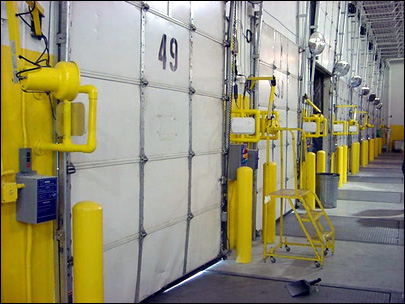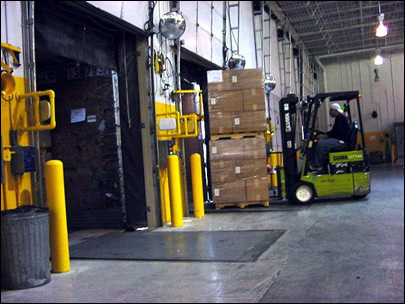The National Center for Employment of the Disabled (NCED) in El Paso, Texas, is a 26-year-old not-for-profit corporation founded to employ disabled workers who would otherwise have difficulty finding work. In addition to making garments for NCED’s government and commercial customers, workers in the El Paso facility manufacture chemical-protection overgarments (CPOs), as well as other military clothing, such as camouflage and dessert battle uniforms, hats and other accessories, for the U.S. Department of Defense (DOD). To comply with an impending RFID tagging mandate from the DOD, as well as to improve its internal inventory tracking and manufacturing processes, NCED has contracted SAIC, a San Diego, Calif., engineering firm, to design and deploy a passive RFID tagging system.
Under an amendment to its DOD supply contract, due to come into effect in the coming months, the NCED must begin attaching RFID-enabled smart labels to cases and pallets of its CPO shipments headed for the DOD’s Defense Logistics Agency (DLA) warehouses. The DLA supplies the U.S. military with clothing and other resources to support operations. Jan Hodges, SAIC’s senior scientist of technology integration, says NCED’s tagging operation is in place and ready to roll, as soon as the DLA warehouses are ready to begin reading and processing RFID data.
|
|
This marks just one part of the first phase of NCED’s RFID deployment, however. The company also plans to use RFID to automate the collection of data needed for inventory control of the CPO raw material, fabric made with a carbon liner that has a shelf life the NCED must observe. Eventually, for phase 2 of the deployment, the NCED plans to expand its RFID system to help automate order processing, production planning and work-in-progress manufacturing.
“Not only are we [deploying the tagging system] to be ready when the DOD requires RFID compliancy, but also for internal process improvements and cost reduction opportunities,” says Ernie Lopez, NCED’s chief operating officer.
“This is not a pilot project,” SAIC’s Hodges maintains. “This is a deployment.” The entire hardware infrastructure is compliant with the EPC Gen 2 Class 1 standard. “We’re getting great read range—as much as 20 feet on our portal readers. We’ve actually had to change our antenna settings to reduce the range,” Hodges says, “and 100 percent of the tags are being read.”
SAIC is using fixed interrogators and tags from Alien Technology, in conjunction with Symbol handheld readers.
The first part of phase 1—the tagging of cases and pallets of finished CPOs as they are being shipped to DLA warehouses—will begin as soon as the warehouses are ready to read the tags. The second part of the first phase involves using RFID to inventory and locate rolls of the fabric used to make the CPOs; this part is already underway. In the second phase, for which the NCED does not yet have a start date, RFID will be used to track the fabric throughout the manufacturing process, as it is cut and sewn into CPOs.
When rolls of the fabric used to make the CPOs arrive from NCED’s supplier, workers at the El Paso facility apply an RFID smart label to each one. Encoded to the tag is a lot ID, saved in a database along with any order information, such as invoice number, relating to that roll. Also encoded to the tag is the warehouse location (isle/shelf) to which the roll is assigned for storage. This location data is be stored in the warehouse management program used to track the rolls in inventory.
Hodges says the NCED is hoping its fabric suppliers will soon begin tagging the rolls of fabric prior to shipping them. That way, the NCED staff would not need to apply the tags themselves, and they could use the tags to receive the goods into inventory.
Once the second phase begins, each time a new roll is needed in the manufacturing facility, the WMS will direct workers to pull it from its assigned location and bring it to the cutting room. Here, the fabric will be spread onto a very large industrial cutter, where portions needed to form the chemically resistant suit components—sleeves, pant legs, etc.—will be cut. Workers will then attach tags to large bundles of cut fabric. Encoded to the tag will be an ID associated with the lot ID from the roll.
Before pulling components from the bundles, workers at sewing stations will use handheld interrogators to read each bundle’s tag. This data will be sent to the NCED’s back-end software to track the manufacturing process. Once each suit is complete, it will be packaged in a plastic bag that could also be tagged, once the DLA begins tracking goods at the item level.
At each step in this process, the RFID tag IDs will be commissioned and, as the tags are read, collected by Radio Frequency Asset System (RFAS), a software platform developed by SAIC for RFID device management and data aggregation. SAIC has developed interfaces between RFAS and the software platforms NCED utilizes. This includes the warehouse management system used to manage its raw materials receiving and inventory system, as well the Apparel Management Accounting System (AMAS) and The Production Manager (TPM) software, used to track the work-in-process manufacturing steps, provided by New Generation Computing.
Throughout this integration, the NCED hopes the unique IDs encoded to the roll and bundle tags, as well as to the tags attached to the cases and pallets of finished goods bound for DLA warehouses, will provide the company more visibility into in-process manufacturing and order fulfillment systems. “In the near future, we’ll have passive RFID tags for all of our many DOD and commercial products, as well as, very possibly, [unique identification] tags in some select uniforms,” says Lopez.



